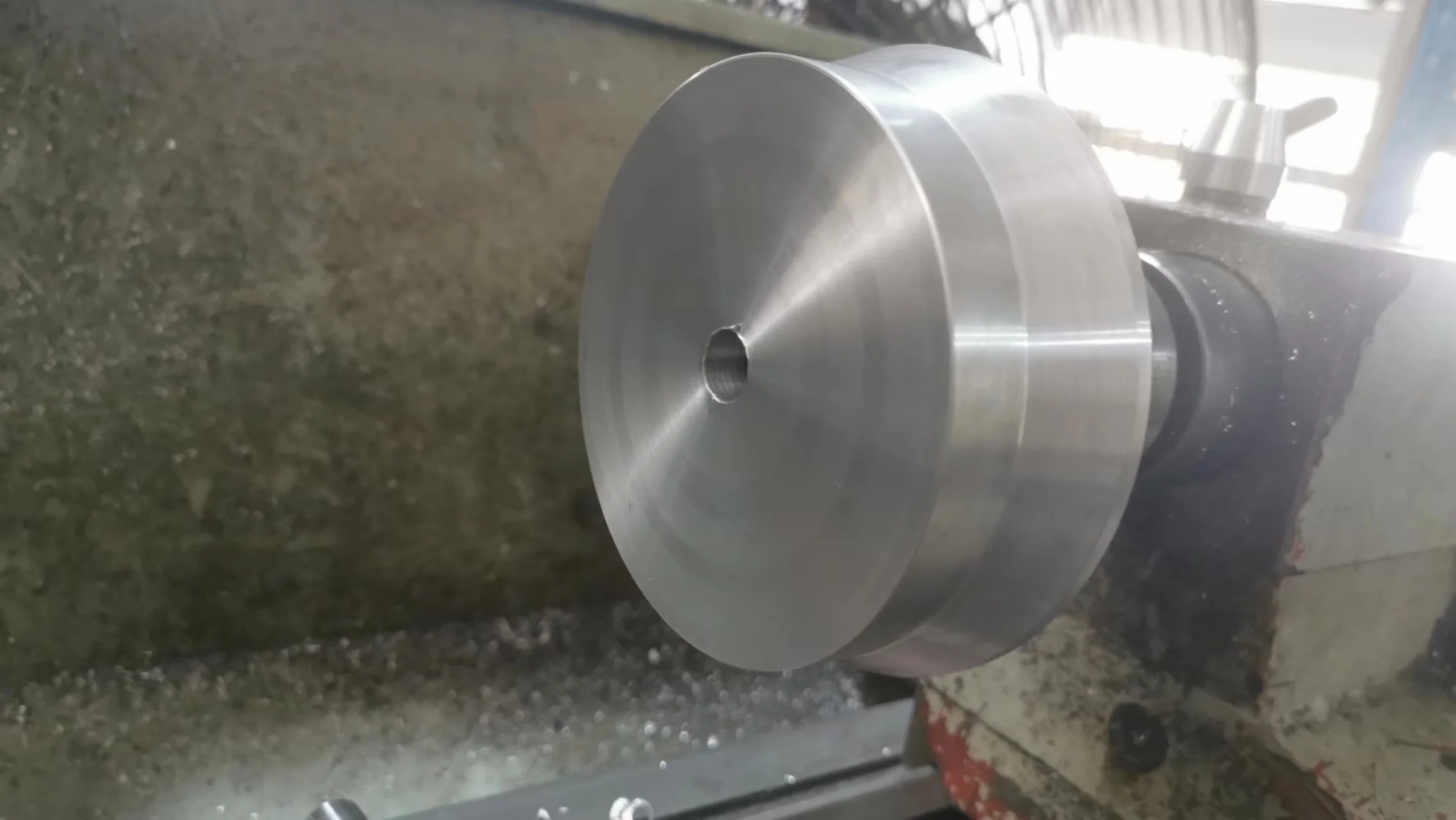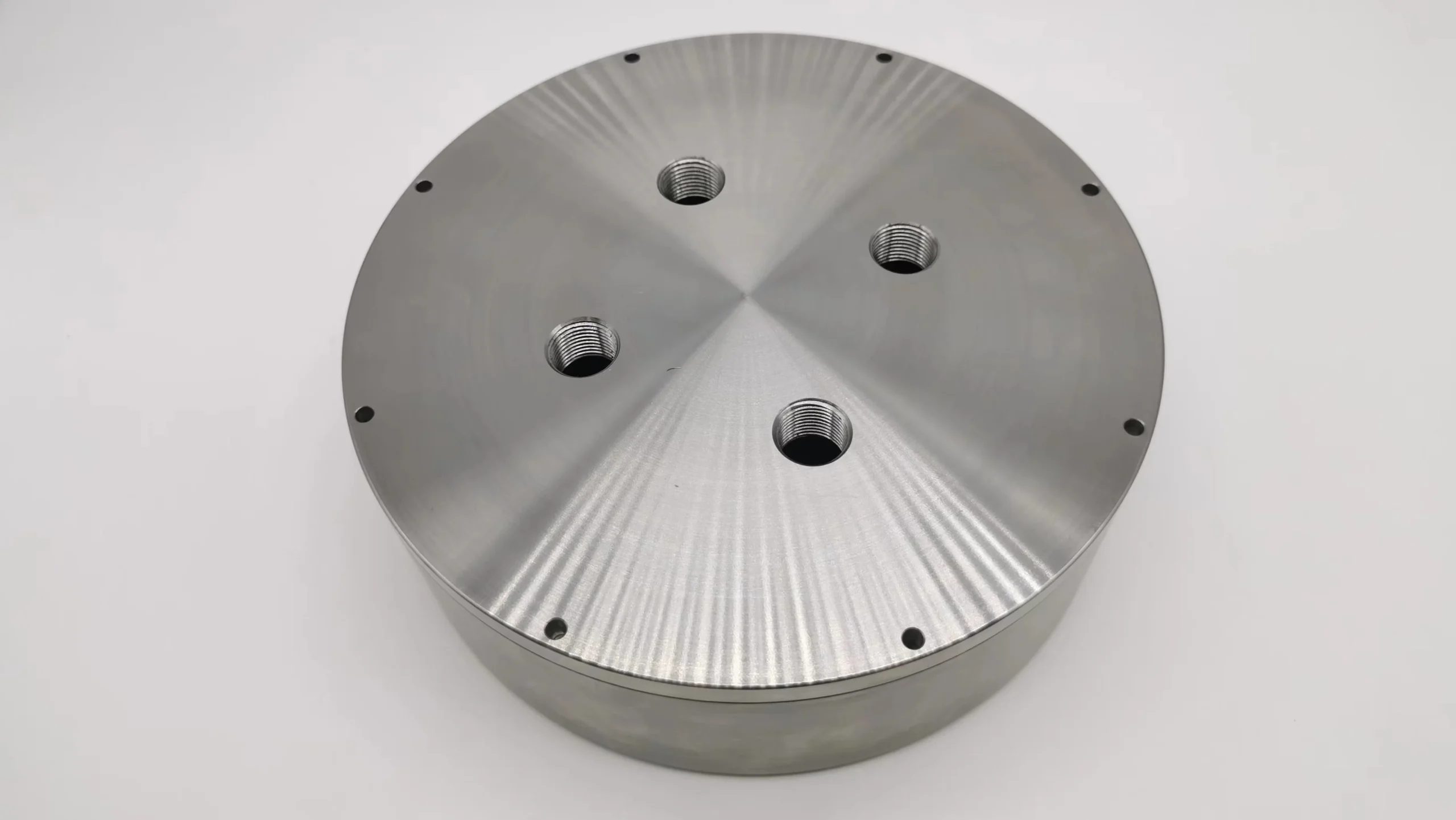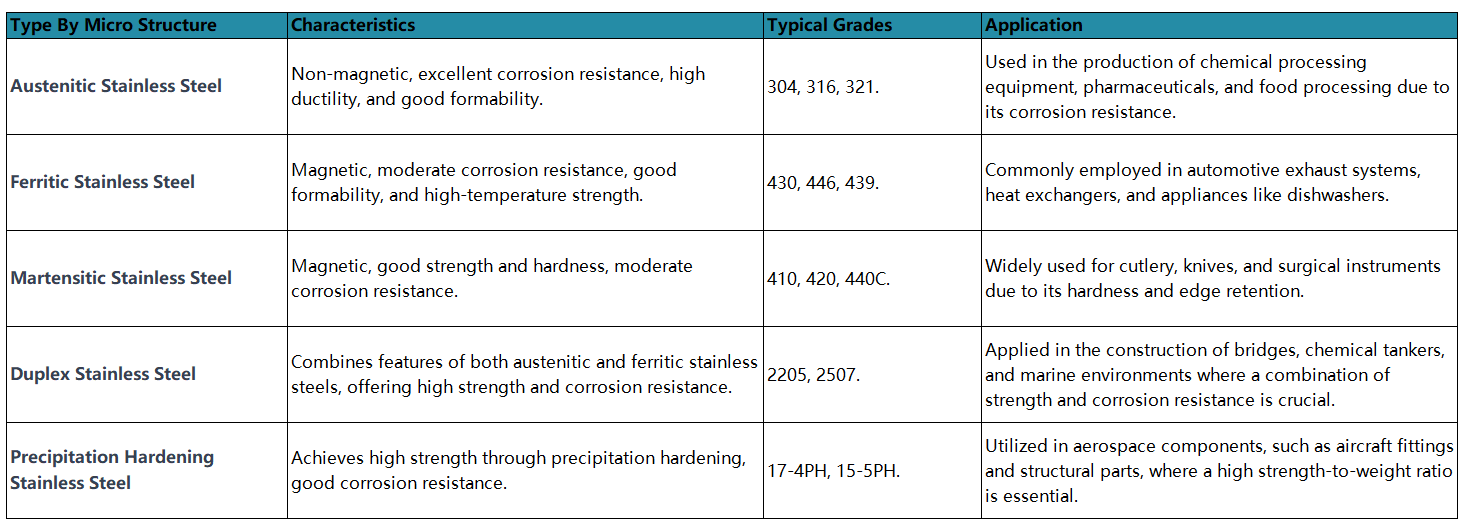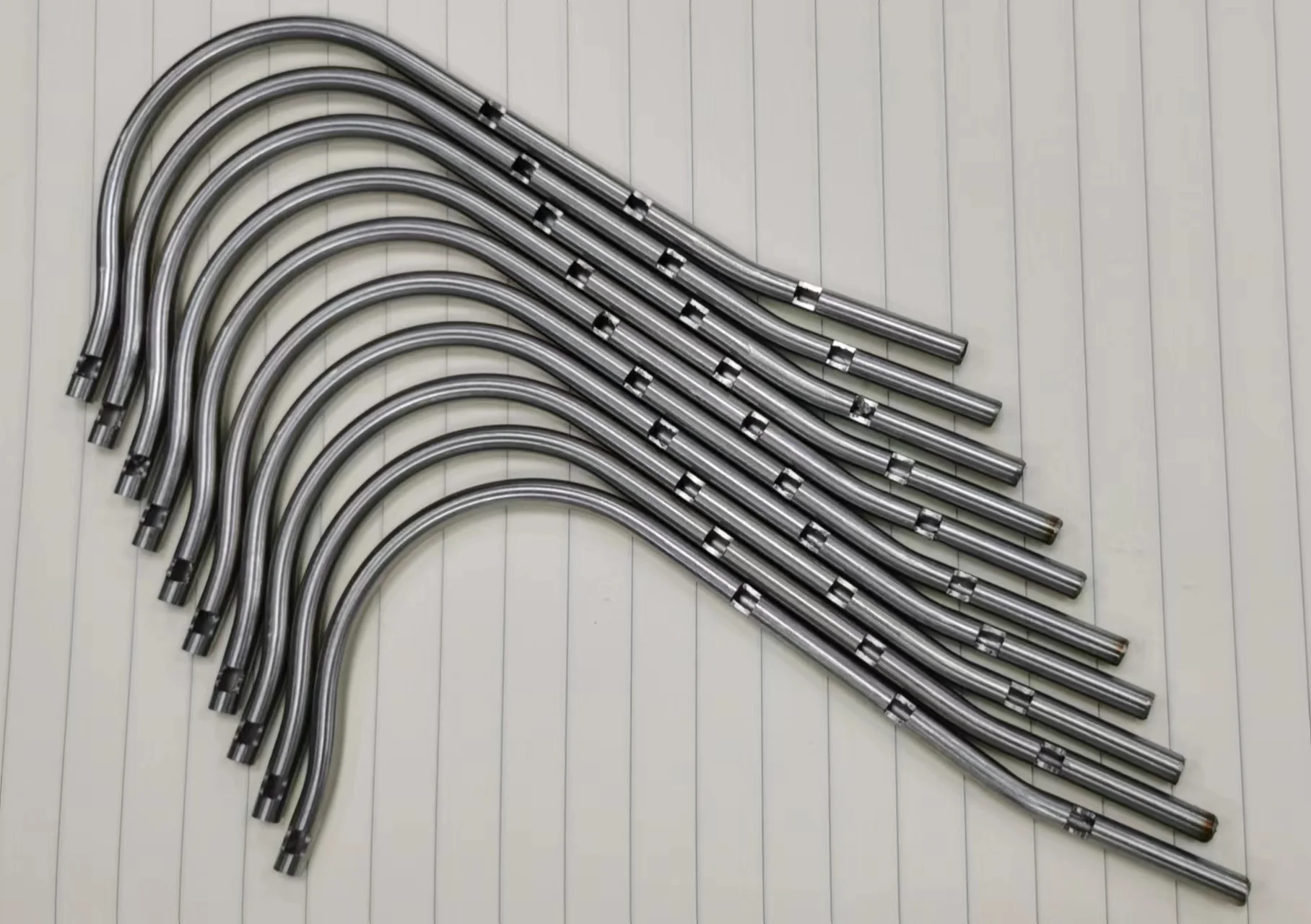Stainless Steel CNC Machining-A Complete Guide 2024
Updated: December 25, 2023
Table of Contents
- 1. What is stainless steel CNC machining?
- 2. What is stainless steel?
- 3. Main properties of CNC machining stainless steel
- 4. Stainless steel classifications
- 5. Importance of stainless steel used in different industries
- 6. Stainless steel machining techniques
- 7. Surface finishes options for stainless steel machined parts
- 8. Best stainless steel alloys for machining
- 9. Factors to consider when choosing a stainless steel grade
- 10. Challenges in stainless steel CNC machining
- 11. Quick tips for CNC machining stainless steel
- 12. FAQs
Stainless steel is commonly used metal in CNC machining. In many industries, we can find stainless steel parts, for example marine, medical, aerospace, automotive and others.
The blog post will introduce the stainless steel types, advantages, and applications. Additionally, we will discuss stainless steel CNC machining techniques, challenges, and machining tips.
1. What is stainless steel CNC machining?
Stainless steel CNC machining refers to using CNC machines to shape, cut, and produce custom stainless steel parts. The process can be either CNC milling or CNC turning. Different types of stainless steel are available, 304, 304L, 316, and 316L.
It also includes the post-process for CNC machining stainless steel. Brushing, polishing, sandblasting and electropolishing are the four common post-treatments.

2. What is stainless steel?
Well known as rustless steel, corrosion-resistant steel, and inox, stainless steel is an alloy iron that contains at least 10.5% chromium, certain nickel, and other elements, for example, carbon.
3. What are the main properties of CNC machining stainless steel?
The main properties of stainless steel are corrosion resistance, high tensile strength, durability, temperature resistance, easy fabrication and form-ability, low maintenance, attractive appearance, and environmentally friendly.
Stainless steel in CNC machining can make durable and long-lasting custom stainless steel parts. The benefits are listed below.
3.1 Corrosion resistant
There is at least 10.5% chromium in stainless steel. Chromium develops a protective layer when subjected to oxygen. Due to the 10.5% high content of chromium, stainless steel is 200 times more resistant to corrosion than steel without chromium.
Chromium makes stainless steel have superb corrosion resistance, effectively withstanding rust and water stains. The corrosion-resistant home makes stainless steel a suitable option for both interior and exterior applications.
3.2 High tensile strength
Stainless steel has better tensile strength compared with aluminum and mild steel, which makes it a favored metal for parts that require resilience and a long lifespan.
3.3 Durable
CNC machining stainless steel parts are always durable due to their excellent corrosion-resistant properties.
3.4 Temperature resistant
304 and 316 stainless steel are high-temperature resistant and can be used for industrial furnaces, exhaust systems, and other heat-intensive processes.
3.5 Easy fabrication and form-ability
Compared with aluminum CNC machining, stainless steel CNC machining is more challenging, because it has a high hardness and toughness.
Choosing the right cutting tools, toolpath planning, and optimizing machining parameters are essential to achieve successful CNC machining of stainless steel.
3.6 Low maintenance
The lifespan of stainless steel parts is long, so the maintenance cost is low.
3.7 Attractive appearance
Stainless steel stays shiny and doesn’t rust or change color because it has chromium inside. CNC-machined stainless steel parts not only offer strength but also show a clear and contemporary appearance, seamlessly combining style with functionality.
3.8 Environmentally friendly
Stainless steel can be repeatedly recycled, making it environmentally friendly.

4. Stainless steel classifications
According to the crystal microstructure, the family of stainless steels is mainly classified into four groups.
4.1 Austenitic Stainless Steel
With at least 8% nickel and 18% chromium, the austenitic stainless steel has a stable austenitic structure. Austenitic stainless steel is known for its toughness and plasticity and is widely used in industrial and domestic applications.
Typical grades like 304 and 316 find wide use in construction, food processing, and medical devices. While 304 is commonly used for kitchen utensils, 316, with its higher corrosion resistance, is preferred for marine and chemical industry applications.
4.2 Ferritic Stainless Steel
Ferritic stainless steel is recognized for its higher hardness and magnetic buildings, mainly composed of iron, chromium, and reduced proportions of nickel.
Types like 430 and 446 are thoroughly made use of in the production of stainless-steel flatware, automobile exhaust systems, and particular family devices. Its stability at heat makes it an ideal selection for particular industrial applications.
4.3 Martensitic Stainless Steel
Martensitic stainless steel is widely used in industries with higher strength and hardness requirements. Composed mainly of higher proportions of carbon and adequate chromium, it achieves excellent performance through heat treatment.
Typical grades like 410, 420, and 440 are used in the manufacturing of cutting tools, bearings, and valves.
4.4 Duplex Stainless Steel
Duplex stainless steel is a special alloy containing both austenitic and ferritic phases, offering high strength and superior corrosion resistance. Mainly composed of higher chromium and lower nickel proportions, it finds applications in chemical industries, marine engineering, and shipbuilding.
Typical grades such as 2205 and 2507 are suitable for harsh environments and highly corrosive media.

5. The importance of CNC machining stainless steel used in different industries
Due to stainless steel’s excellent properties, it finds wide applications in different industries.
- Medical Equipment
Stainless steel is easy to clean and corrosion-resistant and is widely utilized in medical equipment, surgical and dental instruments, operation tables, kidney dishes, MRI scanners and others.
Notably, many surgical implants like replacement joints and artificial hips are crafted from stainless steel, along with associated joining equipment such as pins and plates used for repairing broken bones.
- Automotive
Stainless steel finds widespread application in the automotive industry, making diverse components like exhaust systems, grills, and trims. Stainless steel is also for the fabrication of structural elements within vehicles, highlighting its growing significance in advancing automotive engineering and design.
- Transportation
Stainless steel is widely used in transportation. Transportation parts like containers, trucks and garbage trucks are often made with stainless steel due to its rust resistance. They are great to carry liquids, chemicals, and food.
- Aerospace
Stainless steel is widely used in aerospace because of its strength and can withstand extreme temperatures. Typical aerospace stainless steel parts are airplane frames and landing gear.
- Food
Stainless steel is quite common in the food and catering industry, for example, kitchen essentials, cookware, cutlery, knives, grills, sinks, and others. Freezers, dishwashers, refrigerators, and countertops are also made of stainless steel.
- Marine
Due to its excellent corrosion resistance and durability, stainless steel is widely used in marine. Marine structural components, hardware, boat interiors, propellers, and exhaust systems are often made in stainless steel.

6. Stainless steel machining techniques
Stainless steel can be CNC machined by milling, turning, and sheet metal fabricated.
6.1 Stainless steel CNC milling
Stainless steel CNC milling is challenging because of its high hardness and toughness. By using suitable tools, and controlling cut speed and feed rate, with modern CNC mills, we can get precise CNC milled parts.
6.2 Stainless steel CNC turning
Stainless steel is very suitable for CNC turning due to its good machinability and mechanical properties, especially stainless steel 303.
6.4 Stainless steel sheet metal fabrication
Stainless steel sheet metal fabrication is a typical and vital manufacturing procedure that entails cutting, flexing, marking, welding, and putting together stainless steel sheets according to develop specifications to produce various components and ended up items.
This procedure covers numerous actions, from material option to final quality assurance, where each phase significantly influences the performance and look of completion item.
Stainless steel sheet metal finds prevalent application in sectors such as aerospace, vehicle, electronics, building and construction, and pharmaceuticals, where it is utilized to make top notch, high-precision components and items.
Because of stainless-steel’s high rust resistance, stamina, and sturdiness, sheet metal manufacture with stainless-steel is very preferred in the production industry.

7. Surface finishes options for stainless steel machined parts
For CNC machining stainless steel post-processing, there are four surface treatments mostly used.
7.1 Stainless steel brushing
Stainless steel brushing is a surface treatment that involves stretching, friction or other processes on the surface of stainless steel to create a series of fine and slender textures or stripes. Brushing stainless steel can modify its look and surface structure. Brushing can be categorized into mechanical brushing, chemical cleaning, electrolytic cleaning, friction cleaning, and rotating cleaning.
The benefits of brushing stainless steel include boosting aesthetic allure, minimizing glow, concealing scratches, improving rust resistance, and enhancing tactile feel.
Brushed stainless steel is commonly used in the manufacturing of ornamental materials, furnishings, buildings, auto, and other industries.
7.2 Stainless-steel electropolishing
Stainless steel electropolishing is a surface area treatment that using an electrolytic response to its surface area finish, modifying the surface problem, and boosting the surface level of smoothness and brightness.
In the electropolishing process, the stainless-steel work surface is submersed in an electrolyte option and acts as the anode, permitting electric current to move. Through electrolytic responses, metal on the surface liquifies and re-deposits, resulting in raised surface area smoothness and the removal of issues, oxide layers, and various other disproportions.
Stainless steel surfaces treated with electropolishing commonly display higher reflectivity, a smoother texture, and boosted rust resistance.
Electropolishing stainless steel is extensively used in making industry and ornamental industries.
7.3 Stainless steel polishing
Stainless steel polishing is the surface treatment of stainless steel through mechanical or chemical methods to enhance its smoothness, glossiness, and overall visual quality.
The purpose of polishing is to remove defects, oxide layers, scratches, and other unevenness on stainless steel surfaces, creating a brighter and more decorative appearance.
Stainless steel polishing can be classified into mechanical polishing and chemical polishing.
Mechanical polishing involves using mechanical equipment such as grinders, polishers, or sandpaper to rub and grind the surface of stainless steel.
Chemical polishing involves applying chemical substances such as polishing agents or acidic solutions to the surface of stainless steel to dissolve and remove oxide layers and dirt.
After polishing, the surface of stainless steel is typically smoother and glossier, resembling a mirror-like effect. This treatment not only enhances the visual quality of stainless steel but also improves its corrosion resistance.
Polished stainless steel is suitable for applications with high surface requirements, such as decoration, furniture manufacturing, and medical instruments.
7.4 Stainless steel sandblasting
Stainless steel sandblasting is the surface treatment of projecting sand grains, or other particles onto the surface of stainless steel to create a matte, abrasive, or rough effect, altering its appearance and texture.
The purpose of sandblasting includes eliminating the gloss on the surface of stainless steel, creating a visual effect of sanding, while also concealing surface imperfections and scratches.
8. Best stainless steel alloys for machining
When we talk about the best stainless steels for machining, we generally refer to types that are widely used and have mature machining techniques. From the table, we can have basic information about the best stainless steel alloys for machining.
| Type | Description | Advantages | Disadvantages | Applications |
| Stainless Steel 303 | Belongs to austenitic stainless steel family with a face-centered cubic crystal structure. | Excellent machinability. Good corrosion resistance. | Poor weldability. Lower wear resistance. | Automatic mechanical parts such as bolts, screws, shafts, and nuts. Instruments manufacturing and some chemical experimental equipment. Food processing equipment. |
| Stainless Steel 304 | Belongs to austenitic stainless steel family with a face-centered cubic crystal structure. | Excellent corrosion resistance. High-temperature oxidation resistance. Good machinability. | Decreased impact toughness in extremely low-temperature environments. Poor corrosion resistance in some highly corrosive environments. | Construction Food processing Industry chemical industry |
| Stainless Steel 316 | Belongs to austenitic stainless steel family with a face-centered cubic crystal structure. | Excellent corrosion resistance. Excellent high-temperature oxidation resistance. Good weldability. | Higher cost. Lower hardness. | Marine environment. Chemical industry. Medical instruments. |
| Stainless Steel 416 | Belongs to the martensitic stainless steel family with a body-centered cubic crystal structure. | Excellent machinability. Moderate corrosion resistance. | Relatively lower corrosion resistance. Not suitable for high-temperature environments. | Mechanical parts. Cutting tools and blades. Food processing equipment. |
| Stainless Steel 17-4PH | Belongs to ferritic-martensitic stainless steel family with a mixed crystal structure of ferrite and martensite. | Excellent mechanical properties. Corrosion resistance. Adjustability. | Higher manufacturing cost. Moderate machinability. | Aerospace industry. Medical devices. Chemical processing equipment. |
9. Factors to consider when choosing a stainless steel gradefor cnc machining
To choose the right grade stainless steel for CNC machining, there are many factors to be considered. There are many grades in the market, so narrowing your choice could be challenging. By considering the following factors, you can determine which grade is best for you easier.
9.1 Strength
Tensile strength often plays a crucial role in selecting the optimal material for your project. It is advisable to gain insight into the forces and loads anticipated by your components, comparing them with the diverse range of tensile strengths available. This approach will assist you in ruling out materials that do not meet the necessary strength criteria, ensuring a more informed material selection process.
9.2 Heat treatment
If you need your parts to be a certain level of hardness, you can think about using heat treatment. Just keep in mind that while heat treatment makes parts harder, it might affect other mechanical properties. Also, remember that you can’t heat-treat austenitic stainless steels, so you might want to consider types.
9.3 Magnetism
For some projects, the magnetic factor is also needed to be taken into consideration. Remember that austenitic steel is non-magnetic due to its microstructure.
9.4 Cost
If keeping costs low is your top priority, remember that material expenses are just one aspect of the total cost. To cut costs, try minimizing machining steps and simplifying your parts as much as you can.

10. Challenges in Stainless Steel CNC Machining
As mentioned earlier, machining stainless steel can be one of the challenges compared to machining aluminum. We will now discuss the difficulties encountered in the stainless steel machining process and measures to address them.
10.1 Tool wear
In the CNC machining process of stainless steel, tool wear is common due to the hardness and abrasiveness of stainless steel.
Including using a high-quality tool, it is also helpful to use side milling to produce custom stainless steel parts.
10.2 Chatter
In the process of stainless steel cnc machining, it is common to encounter problems such as tool chatter and ugly tool marks.
Choosing specialized, high-quality imported tools can effectively reduce tool chatter and achieve CNC machined parts with beautiful and shiny surfaces, such as carbide tools and coated tools. Regularly inspect the tool wear and replace it timely.
Recommended stainless steel machining tools GESAC.
10.3 Drill bit overheat
The high strength and abrasiveness of stainless steel can produce considerable heat throughout the drilling procedure, leading to tool wear, reduced efficiency, and potential overheating concerns.
Applying correct reducing parameters, using ideal cutting tools, and ensuring reliable cooling/lubrication are vital measures to stay clear of overheating and boost the exploration process.
10.4 Reduced machining speed
With the same design in cnc milling, the machining speed for stainless steel components is frequently much slower than that of aluminum machining, often around half that rate.
The increased strength and abrasiveness of stainless steel need reducing cutting speeds to ensure correct tool life, lower wear on cutting devices, and maintain machining precision.
According to our manufacturing experience, in cnc milling, the depth of cut, or thickness of the material removed in a single pass, is restricted to around 0.3 mm per pass. This constraint is influenced by variables such as the solidity of stainless steel, tool material, reducing rate, and other machining criteria.
Trying to eliminate a bigger quantity of material in a pass might cause raised tool wear, too much heat generation, and lowered machining efficiency. To accomplish specific and reliable machining, multiple passes with smaller midsts of cut are often preferred.
10.5 Avoid grinding
CNC-machined stainless steel parts are generally not considered friendly to grinding processes. Because grinding introduces heat and mechanical stresses. When grinding CNC-machined stainless steel parts, it is commonly recommended to use water or a coolant as a lubricant and cooling agent.
Water or coolant can improve the surface finish, prevent thermal damage, avoid heat deformation, and extend the life of the grinding wheel.
Plus, magnetic clamping is commonly used in grinding operations. The magnetic force between the chuck and the ferrous material of the workpiece ensures stability and proper fixation.
However, for austenitic stainless steel, which is non-magnetic, mechanical or vacuum clamping shall be considered instead of magnetic clamping systems.
11. Quick tips for CNC machining stainless steel
11.1 Choose high-quality machining tool
High-quality tools, for example, molybdenum or tungsten HSS end mills and drills, can stand the stress and heat during the process with minimal wear. Chatter will be reduced and surface finish will be improved.
11.2 Manage heat during stainless steel cnc machining
The control of heat generated is crucial to the success of stainless steel CNC machining. Using a coolant and keeping a lower cutting speed help manage the heat.
11.3 Use pecking and chip-breaking cycles
Implementing pecking and chip-breaking cycles during machining is a practical approach to control chip formation. This method aids in the elimination of long and stringy chips.
Additionally, regularly inspecting cutting tools is another effective strategy for managing chip formation, as worn tools are more likely to produce undesirable chip shapes.
11.4 Avoid Deformation
Many factors can lead to workpiece deformation, for example, cutting speed, feeding rate, and cutting tools. Deformation can cause machined parts out of tolerance. Setting the right cutting speed and feed rate is crucial.
Stainless steel CNC machining services are recommended. Stainless steel machining can be challenging and requires a lot of expertise.
Start your project with a stainless steel CNC machining manufacturer with rich experience, consistent quality ad timely delivery.

12. FAQs about stainless steel cnc machining
12.1 Can stainless steel be CNC machined?
Yes, stainless steel can be CNC machined, both milling and turning, though the machining of stainless steel requires rich machining experiences.
12.2 Is stainless steel hard for cnc machining?
Stainless steel has high strength and toughness, which makes machining become hard.
12.3 Which stainless steel is easiest for cnc machining?
303 is the easiest stainless steel for CNC machining.
12.4 What is the hardest machinable stainless steel?
Grade 440C. It is a high-carbon, high-chromium stainless steel with excellent hardness, wear resistance, and corrosion resistance.
12.5 In CNC machining, which types of stainless steel are often used?
304 and 306.
12.6 Is 304 easier for machining than 316?
316 is easier than 304.
12.7 Which process is easier for stainless steel?
Generally speaking, turning in stainless steel is easier than milling.